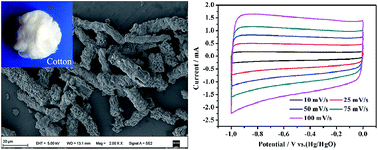Cotton-based porous activated carbon with a large specific surface area as an electrode material for high-performance supercapacitors
Abstract
Cotton-based porous activated carbons (CACs) are prepared through a simple chemical activation method using cotton fiber as carbon source and ZnCl2 as activating agent. Powder X-ray diffraction, scanning electron microscopy, and N2 adsorption–desorption tests demonstrate that the carbons activated with different amounts of ZnCl2 have a large number of mesopores, notably, a maximum specific surface area of 2548.6 m2 g−1 and ultrahigh pore volume of 1.54 cm3 g−1 for CAC2 sample are obtained when the cotton/ZnCl2 mass ratio is 1 : 2. As an electrode material for supercapacitors, the CAC2 possesses a high specific capacitance of 239 F g−1 at 0.5 A g−1 and good rate capability (82% capacitance retention even at 8 A g−1) in 2 mol L−1 KOH aqueous electrolyte. Moreover, the as-assembled CAC2//CAC2 symmetric supercapacitor exhibits a high energy density of 13.75 Wh kg−1 at a power density of 225 W kg−1 operated at the voltage range of 0 to 1.8 V in 0.5 mol L−1 Na2SO4 aqueous electrolyte and an excellent cyclability retaining about 93% initial capacitance after 5000 cycles.


 Please wait while we load your content...
Please wait while we load your content...